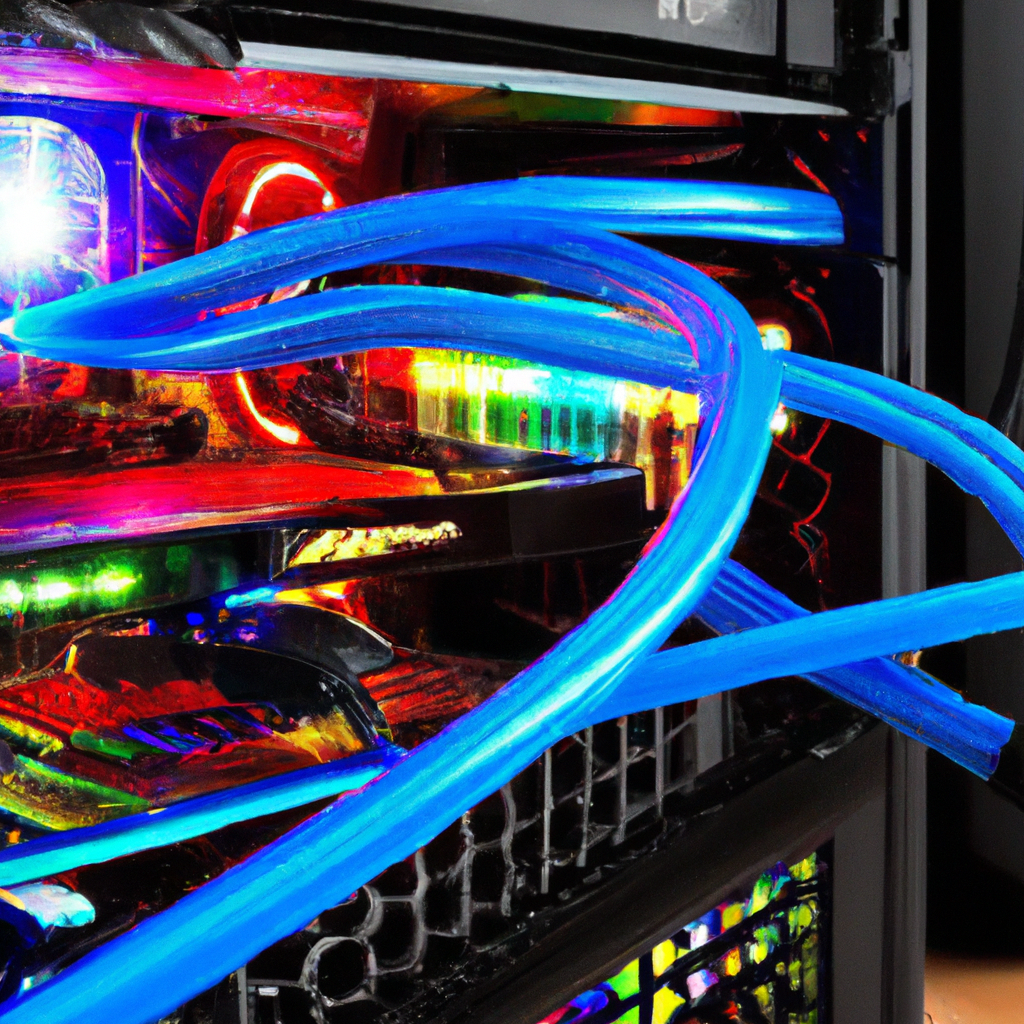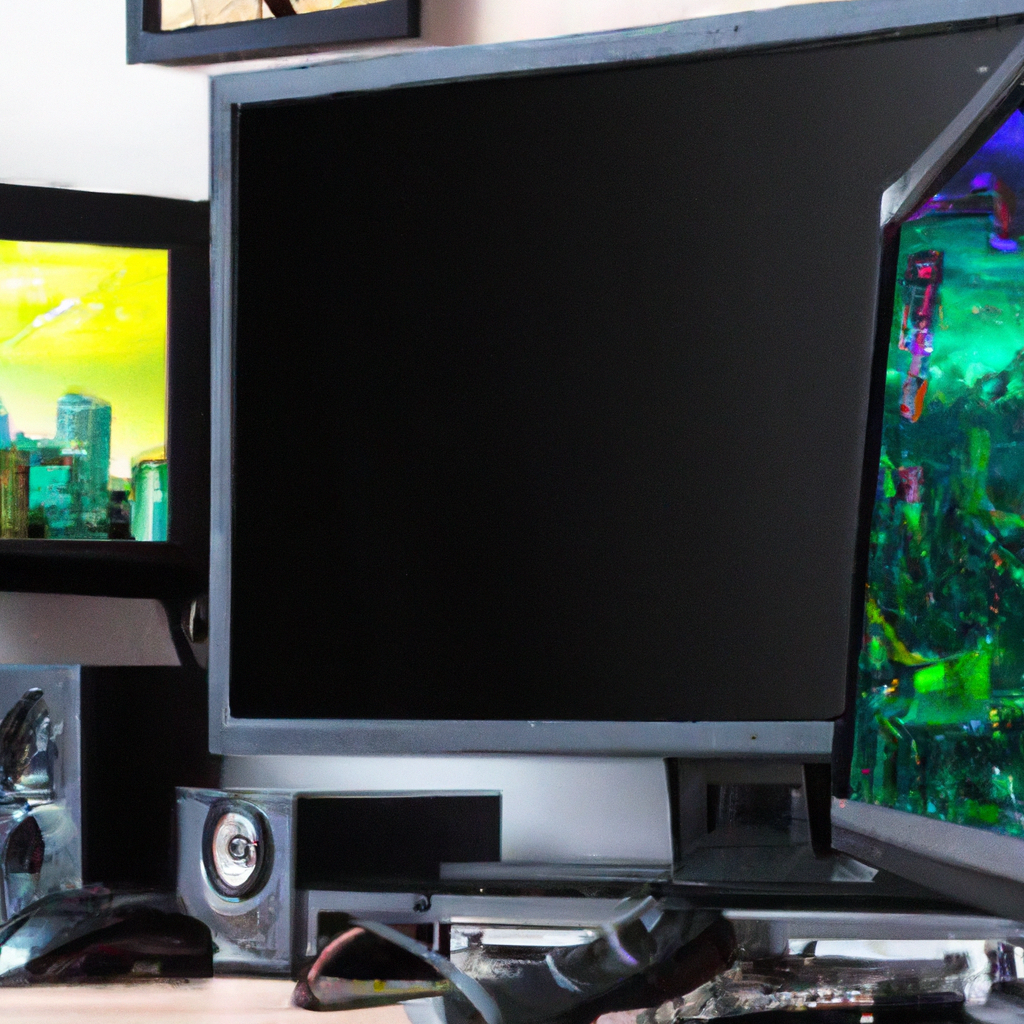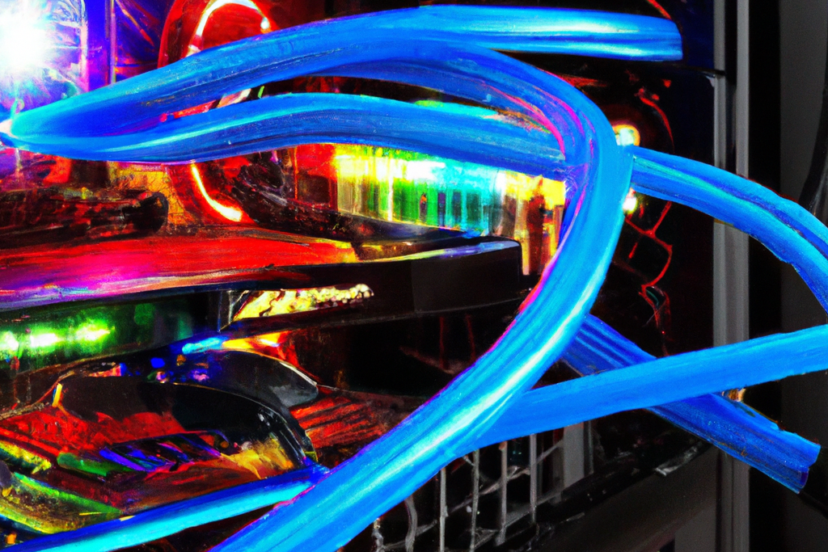How Do You Manage Cables In A Gaming Setup? 10 Handy Tips and Tricks
In the world of gaming, the last thing you want is a tangled mess of cables ruining your immersive gaming experience. Whether you’re a casual gamer or a serious enthusiast, organizing and managing cables in your gaming setup is crucial for both aesthetics and functionality. With a few simple tips and tricks, you can say goodbye to cable chaos and we’ll answer the question, “How do you manage cables in a gaming setup” to ensure a clean and efficient gaming environment.

1. Identify the types of cables in your gaming setup
When it comes to managing cables in your gaming setup, the first step is to identify the different types of cables you are working with. Here are some of the most common cables you might find:
1.1 HDMI cables
HDMI cables are essential for connecting your gaming console or PC to your television or monitor. These cables transmit both high-definition video and audio signals, ensuring a seamless gaming experience.
1.2 Power cables
Power cables are necessary to provide electricity to your gaming devices. They connect your gaming console, PC, or other gaming peripherals to a power outlet, keeping everything up and running.
1.3 Ethernet cables
Ethernet cables are used to establish a wired internet connection for your gaming setup. They allow for a stable and reliable internet connection, which is crucial for online gaming and reducing lag.
1.4 USB cables
USB cables are versatile connectors used for various purposes in a gaming setup. They can be used to connect gaming controllers, keyboards, mice, and other peripherals to your gaming device.
1.5 Audio cables
Audio cables are used to transmit audio signals from your gaming devices to speakers, headphones, or gaming headsets. These cables ensure that you can hear the in-game sounds and communicate with other players effectively.
1.6 Display cables
Display cables, such as DisplayPort or DVI cables, are required to connect your gaming device to a display. They transmit video signals and provide high-quality visuals for your gaming experience.
2. Plan the cable management
Once you have identified the types of cables in your gaming setup, it’s crucial to plan how you will manage them effectively. Consider the following factors to ensure an organized and clutter-free setup:
2.1 Determine cable paths
Start by determining the optimal cable paths in your gaming setup. Plan where each cable will run, taking into account the distance between your gaming devices and the available outlets or ports.
2.2 Organize cables by function
To make your cable management more efficient, consider organizing cables by their function. For example, keep power cables separate from data cables and audio cables separate from video cables. This will make it easier to identify and manage specific cables when needed.
2.3 Consider cable length
When purchasing cables for your gaming setup, consider the appropriate cable length. Avoid using excessively long cables as they can lead to unnecessary cable clutter. Choose cables that are long enough to reach their intended destinations without excess slack.
2.4 Think about cable accessibility
Ensure that your cables are easily accessible whenever you need to make adjustments or connections. Avoid hiding them behind furniture or equipment that may make it difficult to reach them when necessary.
2.5 Take aesthetics into account
While functionality is essential, aesthetics also play a role in cable management. Consider the overall appearance of your gaming setup and strive for a clean and organized look. Choose cable management solutions that blend well with your gaming environment and keep cables out of sight as much as possible.
3. Use cable management products
To further enhance the organization and tidiness of your gaming setup, utilize various cable management products. Here are some useful options to consider:
3.1 Cable ties and zip ties
Cable ties or zip ties are versatile solutions that can keep your cables secure and tidy. Use them to bundle cables together, preventing them from tangling and creating a neat and organized appearance.
3.2 Cable clips and holders
Cable clips and holders are designed to attach to surfaces, keeping cables in place and preventing them from falling or tangling. They are ideal for securing cables along the edges of your desk or other surfaces.
3.3 Cable sleeves
Cable sleeves are flexible covers that enclose multiple cables, providing a streamlined and organized appearance. They are particularly useful for managing cables that run together, such as those behind your desk or entertainment center.
3.4 Cable raceways
Cable raceways are channels or ducts that can be mounted on walls or along baseboards to hide and manage cables. They offer a seamless and professional look, keeping cables out of sight and minimizing visual clutter.
3.5 Cable management boxes
Cable management boxes are larger containers that can hold multiple cables, power adapters, and other accessories. They keep all your cables neatly contained and provide a convenient solution for managing excess cable length.
3.6 Cable labels
To easily identify and differentiate cables, consider using cable labels. Labeling cables can be especially helpful when you have multiple devices or similar-looking cables. Use cable labels or tags to mark each cable’s purpose or destination.
4. Choose the right cables
Choosing the right cables for your gaming setup is key to efficient cable management and optimal performance. Consider the following factors when selecting cables:
4.1 Use shorter cables
Using shorter cables can help minimize cable clutter. Measure the distance between your gaming devices and the corresponding ports or connectors and choose cables that are just long enough to reach without excess slack.
4.2 Opt for high-quality cables
Investing in high-quality cables can significantly improve your gaming experience. High-quality cables are more durable, less prone to interference, and provide better signal transmission. They are worth the investment for long-term cable management and performance.
4.3 Consider cable color
When aesthetics are a priority, consider the color of your cables. Opt for cables in colors that match or blend well with your gaming setup. This can create a more visually appealing and cohesive look, especially when cables are partially visible.

5. Route cables properly
Routing your cables properly is crucial for both organization and performance. Follow these tips to ensure effective cable routing:
5.1 Separate power and data cables
To minimize potential interference or signal degradation, it is important to separate power cables from data cables. Keep them as far apart as possible and avoid crossing them over one another.
5.2 Keep cables away from heat sources
To prevent damage to your cables, keep them away from heat sources like heating vents, radiators, or other devices that generate heat. Excessive heat can degrade cable performance and affect their longevity.
5.3 Avoid tightly bending cables
Avoid tightly bending cables, especially in sharp angles or loops. Over time, this can cause damage to the cables and impact signal transmission. Use gentle curves and avoid bending them excessively to preserve their integrity.
5.4 Route cables behind furniture or along walls
To keep cables out of sight and prevent them from being accidentally pulled or tripped over, consider routing them behind furniture or along walls. This can create a cleaner look and minimize the risk of damage or disconnection.
5.5 Utilize cable management holes or grommets
If your gaming desk or furniture has built-in cable management features like holes or grommets, make use of them. These features are designed to guide cables through and keep them organized and hidden from view.
6. Organize cables behind your gaming desk
The area behind your gaming desk is often a hot spot for cable clutter. Implement these strategies to keep things organized:
6.1 Use cable trays or baskets
Cable trays or baskets are practical solutions for collecting and holding cables together behind your desk. Place them beneath your desk to provide a dedicated space for cables to prevent them from tangling or dragging on the floor.
6.2 Attach cables to the back of your desk
Secure cables to the back of your desk using adhesive clips or zip ties. This prevents cables from dangling or falling behind your desk and keeps them tidy and out of sight.
6.3 Use adhesive hooks or clips
Adhesive hooks or clips can be utilized to hold cables along the edges or sides of your desk. This keeps them organized and prevents them from tangling or getting caught on other objects.
6.4 Bundle and secure cables together
Use cable ties or velcro wraps to bundle cables together behind your desk. This ensures that they stay organized and reduces the chances of them becoming tangled or accidentally unplugged.

7. Clean up cable tangles
Over time, cables can become tangled or disorganized. Follow these steps to clean up cable tangles:
7.1 Untangle cables carefully
When faced with tangled cables, take the time to carefully untangle them. Avoid pulling or yanking on cables forcefully, as this could damage them. Gently separate each cable, starting from the tangle’s outer edges and working your way inward.
7.2 Use cable wraps or Velcro ties
Once untangled, use cable wraps or Velcro ties to secure individual cables or groups of cables together. This prevents them from becoming tangled again and helps to maintain an organized setup.
7.3 Label or color-code cables
To make cable identification easier in the future, consider using labels or color-coding techniques. Label or tag each cable with its corresponding device or purpose. Color-coded labels can also help distinguish cables at a glance.
7.4 Regularly check and organize cables
Make it a habit to regularly check and organize your cables. Take a few minutes each month to assess the cable management behind your gaming desk and make any necessary adjustments. This proactive approach will help prevent cable tangles and keep your setup optimized.
8. Reduce cable clutter on your gaming PC
Managing cables on your gaming PC is essential for both functionality and aesthetics. Here are some tips to reduce cable clutter on your gaming PC:
8.1 Opt for wireless peripherals
Consider using wireless peripherals such as gaming keyboards, mice, and controllers. This eliminates the need for cables connected directly to your PC, reducing clutter and providing a more streamlined setup.
8.2 Utilize internal cable management options
Many gaming PC cases have built-in features for internal cable management. Take advantage of these options by routing and securing cables inside the case, preventing them from obstructing airflow and reducing clutter around your PC.
8.3 Use cable combs or clips for neat cable routing
Cable combs or clips can be attached to the interior of your PC case to organize and align cables neatly. They keep cables in place and prevent them from intertwining, resulting in a cleaner and more organized appearance.
8.4 Organize and secure cables with cable ties
Use cable ties to group cables together inside your PC case. This prevents cables from moving around and reduces clutter. Additionally, shorter cables can be tied together and tucked away behind the motherboard tray or other areas to minimize visibility.
8.5 Choose a case with good cable management features
When selecting a gaming PC case, prioritize those with good cable management features such as routing holes, tie-down points, and ample space behind the motherboard tray. A case designed with cable management in mind will make it easier to keep cables organized and reduce clutter.

9. Consider cable management in wall-mounted setups
In wall-mounted gaming setups, managing cables is essential for maintaining a clean and organized appearance. Consider the following tips:
9.1 Plan cable routes before mounting
Before mounting your gaming devices on the wall, plan the cable routes carefully. Identify the optimal path for each cable and determine how they will be concealed or managed to maintain a clutter-free look.
9.2 Conceal cables with cable raceways or channels
Cable raceways or channels are excellent solutions for hiding cables in wall-mounted setups. Mount them to the wall and feed the cables through, creating a discrete pathway for the cables. This keeps them out of sight and prevents them from being exposed.
9.3 Use in-wall cable management solutions
For a more integrated approach, consider in-wall cable management solutions. These involve running cables through the wall itself, either by cutting a channel or utilizing existing conduits. This can provide a seamless and professional appearance, but it may require professional assistance.
9.4 Install cable management boxes behind the TV or monitor
If your gaming devices are wall-mounted, consider installing cable management boxes behind the TV or monitor. These boxes provide a dedicated space for cables to be routed and securely stored, keeping them organized and hidden from view.
9.5 Hide cables with cord covers
Cord covers are ideal for concealing cables that run from your wall-mounted gaming devices to power outlets or other connections. These covers typically have adhesive backing and can be easily attached to walls, providing a neat and unobtrusive solution.
10. Test and troubleshoot cable connections
After completing your cable management efforts, it is crucial to test and troubleshoot your cable connections. Follow these steps to ensure everything is functioning correctly:
10.1 Check for loose or disconnected cables
Inspect each cable connection to ensure they are secure and properly plugged in. Loose or disconnected cables can result in unreliable connections or compromised performance. Firmly reconnect any cables that may have become loose during the cable management process.
10.2 Use cable testers to ensure proper functionality
If you suspect any issues with cable connections, use cable testers to check for proper functionality. Cable testers can identify any faults or inconsistencies in the cables, allowing you to rectify them before they impact your gaming experience.
10.3 Troubleshoot connectivity issues
If you encounter connectivity issues after organizing your cables, troubleshoot the problem systematically. Start by checking cables for any signs of damage, ensuring they are connected to the correct ports, and verifying that all settings are properly configured. If necessary, consult troubleshooting guides or seek assistance from technical support.
By following these comprehensive cable management strategies, you can ensure that your gaming setup remains organized, efficient, and visually appealing. Not only will a well-managed cable setup enhance your gaming experience, but it can also streamline your overall computer setup. So get started and take control of those cables for a clutter-free gaming experience!

Conclusion: Mastering Cable Management in Your Ultimate Gaming Setup
In summary, managing cables in a gaming setup is much more than a mere afterthought; it’s an integral part of creating an optimized, efficient, and aesthetically pleasing gaming environment. From the moment you unbox your shiny new gaming peripherals to the point where you’re deep into a gaming marathon, the last thing you want to worry about is a jungle of cables disrupting your focus, or worse, your gameplay. So, let’s revisit some of the key points we’ve covered on how to manage cables in a gaming setup effectively.
Identification and Planning: Knowing what cables you have and where they will go is the foundation of effective cable management. Sketching out a layout or even mentally planning your setup can save you a lot of time and frustration later.
Types of Cable Management Tools: From Velcro ties and cable sleeves to under-desk cable trays and cable clips, using the right combination of these tools can turn a tangled mess into a neat, unobtrusive system. Don’t underestimate the impact of these seemingly minor accessories; they can make a monumental difference.
Routing and Grouping: Guiding cables through the most efficient paths and grouping similar or connected cables together can drastically improve both the look and functionality of your setup. Remember, the shorter the cable path, the cleaner your setup will look and feel.
Regular Maintenance: Cable management is not a “set it and forget it” task. As you upgrade your hardware or introduce new devices into your gaming setup, your cable management strategy should adapt. Make it a point to periodically check and reorganize your cables; this makes it easier to troubleshoot any issues and also gives you an opportunity to clean areas that are typically hard to reach.
Aesthetics and Customization: Beyond functionality, cable management also offers an opportunity to enhance the visual appeal of your setup. Custom cable sleeves, LED lighting, and coordinated color schemes can make your gaming station not just organized, but also uniquely yours.
Health and Safety: An organized cable setup isn’t just about aesthetics; it’s also about ensuring your gaming space is safe. Properly managed cables reduce the risk of tripping, electrical fires, or damaging your expensive gaming equipment.
Future-Proofing: As you ponder how to manage cables in your gaming setup, think about scalability. Opt for solutions that are easy to adapt or expand upon. Your gaming station will likely evolve, and your cable management system should be able to do so as well.
After diving deep into the various methods and tools at your disposal, it should be evident that cable management is both an art and a science. When executed correctly, it contributes to an efficient, hassle-free, and more enjoyable gaming experience. So, invest the time and perhaps a little money into managing those unruly cables; your future self, immersed in an epic gaming session without a cable-induced care in the world, will thank you.




